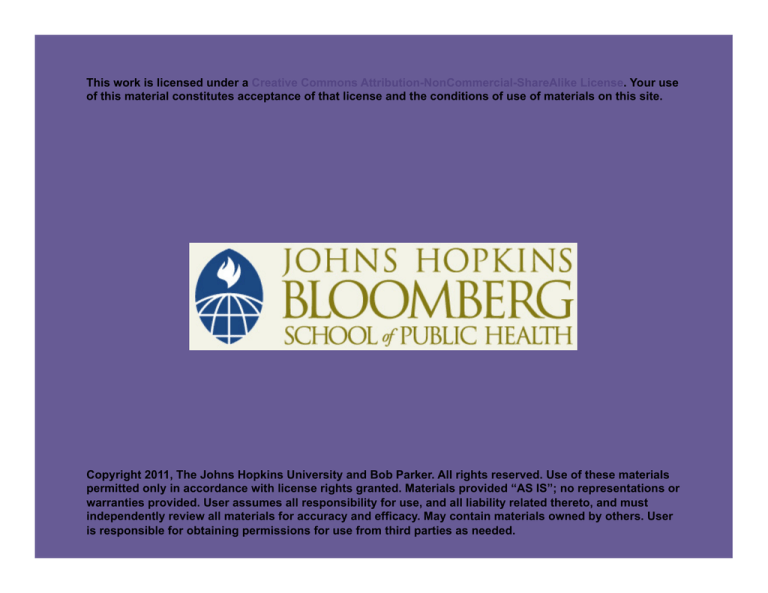
This work is licensed under a Creative Commons Attribution-NonCommercial-ShareAlike License. Your use
of this material constitutes acceptance of that license and the conditions of use of materials on this site.
Copyright 2011, The Johns Hopkins University and Bob Parker. All rights reserved. Use of these materials
permitted only in accordance with license rights granted. Materials provided “AS IS”; no representations or
warranties provided. User assumes all responsibility for use, and all liability related thereto, and must
independently review all materials for accuracy and efficacy. May contain materials owned by others. User
is responsible for obtaining permissions for use from third parties as needed.
Section C: Gadchiroli, India
Robert Parker, MD, MPH
Power of Action-Based Research
“… ‘scientific’ research [at the community level] can be a
powerful change maker … It can knock on the doors of policy
makers, governments, and international agencies and awaken
them to the grassroots problems as well as to the possible
solutions. Time and again we have found this ‘action-research’
approach worked successfully—both at the level of communities
as well as national and international for a. In an ongoing battle
between hospital-centered technocratic health care versus
people-centered empowering health care, we are trying to tilt
the balance towards [empowering] people by way of research and
demonstrations.”
—Abhay and Rani Bang
3
Overview of Search Activities
Sickle Cell Study
Gynecology Study
Community Priorities
Assessed
ARI Studies
HBNC Study
Community-based
Services and Actions
Dissemination, Training,
And Research Center
(“Scale Squared”)
State-wide Child
Mortality Study
ANKUR Study
Trials of HBNC in
India and Other
Countries
4
Entrance to a Clinic and Hospital
Photo: Bob Parker
5
Training Center
Photo: Bob Parker
6
Replication and Scaling-Up
Child mortality studies as an advocacy tool
Use of the SEARCH experience as a “Scale-Squared” center through
publications, popular media publicity, site visits, training courses,
and ongoing research
Extension and evolution of home-based neonatal care (HBNC) in
seven NGOs, the ANKUR project
Introduction of HBNC into government services in five pilot areas of
India
Trials of HBNC in other countries (Bangladesh, Pakistan, Nepal,
eight countries in East Africa)
7
The ANKUR Project
Seven selected NGOs in Maharashtra State
Rural areas, tribal areas, and an urban slum
Two-year baseline data collection of newborn mortality
Orientation and training in the SEARCH model of HBNC in 2001–2002
Completed the intervention phase in 2005
Completed the evaluation, analysis, reporting of results, and an
overall case study in 2006
8
NGO Leader Holding a Planning Meeting
Photo: Bob Parker
9
Village Meeting: Women and Men Sit Separately
Photo: Bob Parker
10
Tribal Village Home
Photo: Bob Parker
11
Close Relationships of the Team
Photo: Bob Parker
12
Support and Training of the Village Health Worker
Photo: Bob Parker
13
Health Workers Discuss Their Training
Photo: Bob Parker
14
Examining a Newborn Baby
Photo: Bob Parker
15
Weighing a Newborn
Photo: Bob Parker
16
A Newborn Receiving an Injection
Photo: Bob Parker
17
Caring for Low Birth Weight (LBW) Babies
Photo: Bob Parker
18
Record Keeping as Part of the Process
Photo: Bob Parker
19
Summary of Results
51% reduction of neonatal mortality rate
- The reduction was 67% by “intent to treat” estimates
38% reduction of 1- to 12-month mortality rate
47% reduction in infant mortality rate
56% reduction in 1- to 4-year mortality rate
31% reduction of sick neonates needing medical attention
20
Some Lessons Learned from ANKUR
Importance of advocacy and early participation of the community in
understanding the problems of newborns
Critical role of adequate orientation and dedication of NGO leaders
and staff through interaction, well publicized ceremonies, and site
visits to see HBNC in action in SEARCH villages
Development and implementation of participatory training of TBAs,
VHWs, and supervisors
- The training was staged, interspersing actual practice in their
communities with the training sessions
Some adaptations of the program were necessary in the tribal and
urban settings
21
Some Lessons Learned from ANKUR
The use of baseline data and prospective monitoring to document
the impact of HBNC
The SEARCH model of HBNC is an intensive program, requiring
careful attention to inputs, processes, and quality in any replication
or scaling-up
The importance of establishing plans for sustainability early in the
life of the project
22
Questions
How did SEARCH balance the goal of testing a new approach to
reducing neonatal deaths with the need to respond to the
community’s priorities?
How important is it to have scientifically valid data to support the
findings of community-based PHC interventions?
How would you take the next step of integrating effective neonatal
care into “safe motherhood” and child health programs within a
comprehensive PHC package?
23




